| Medal | Obverse design | Reverse design | Mintage | Available | Obverse | Reverse |
|---|---|---|---|---|---|---|
| "George Washington" Sons of Liberty bronze medal [1] | George Washington | Liberty Tree, Join, or Die cartoon, and symbol of a two shilling six pence stamp | Proof: ---- P | 1972 |
| Face value | Coin | Obverse design | Reverse design | Mintage | Obverse | Reverse |
|---|---|---|---|---|---|---|
| 2¢ | United States Bicentennial two-cent piece (cancelled) [2] | Unknown | Unknown | None | ||
| 25¢ | United States Bicentennial quarter | George Washington | Drummer boy | Circulation: [3] Uncirculated: [4] 3,814,001 (P) (clad) Contents3-4 (P) (silver) |  |  |
| 50¢ | United States Bicentennial half dollar | John F. Kennedy | Independence Hall | Circulation: [7] 234,308,000 (P) Uncirculated: [4] 3,814,001 (P) (clad) 3-4 (P) (silver) |  |  |
| $1 | United States Bicentennial dollar | Dwight D. Eisenhower | Liberty Bell and the Moon | Circulation: [9] 25,067,710 (P) Uncirculated: [4] 3,814,001 (P) (clad) 4-5 (P) (silver) |  |  |
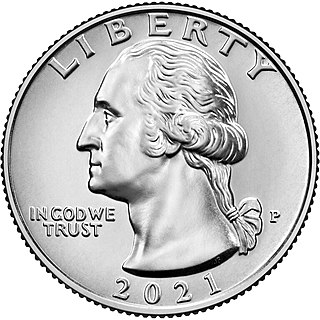
The quarter, short for quarter dollar, is a United States coin worth 25 cents, one-quarter of a dollar. The coin sports the profile of George Washington on its obverse, and after 1998 its reverse design has changed frequently. It has been produced on and off since 1796 and consistently since 1831.

The United States one-cent coin, often called the "penny", is a unit of currency equaling one one-hundredth of a United States dollar. It has been the lowest face-value physical unit of U.S. currency since the abolition of the half-cent in 1857. The first U.S. cent was produced in 1787, and the cent has been issued primarily as a copper or copper-plated coin throughout its history.
The United States Mint has minted numerous commemorative coins to commemorate persons, places, events, and institutions since 1848. Many of these coins are not intended for general circulation, but are still legal tender. The mint also produces commemorative medals, which are similar to coins but do not have a face value, and therefore are not legal tender.
The dollar coin is a United States coin with a face value of one United States dollar. Dollar coins have been minted in the United States in gold, silver, and base metal versions. Dollar coins were first minted in the United States in 1794.
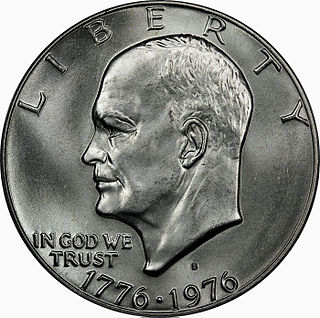
The United States Bicentennial coinage is a set of circulating commemorative coins, consisting of a quarter, half dollar and dollar struck by the United States Mint in 1975 and 1976. Regardless of when struck, each coin bears the double date 1776–1976 on the normal obverses for the Washington quarter, Kennedy half dollar and Eisenhower dollar. No coins dated 1975 of any of the three denominations were minted.

The Eisenhower dollar was a one-dollar coin issued by the United States Mint from 1971 to 1978; it was the first coin of that denomination issued by the Mint since the Peace dollar series ended in 1935. The coin depicts President Dwight D. Eisenhower on the obverse, and a stylized image honoring the 1969 Apollo 11 Moon mission on the reverse, with both sides designed by Frank Gasparro. It is the only large-size U.S. dollar coin whose circulation strikes contained no silver.

The American Silver Eagle is the official silver bullion coin of the United States.
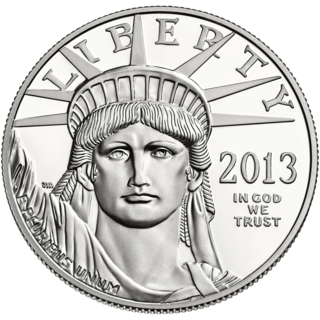
The American Platinum Eagle is the official platinum bullion coin of the United States. In 1995, Director of the United States Mint Philip N. Diehl, American Numismatic Association President David L. Ganz, and Platinum Guild International Executive Director Jacques Luben began the legislative process of creating the Platinum Eagle. After over two years of work, the 99.95% fine platinum coins were released by the United States Mint in 1⁄10, 1⁄4, 1⁄2 and 1 troy oz denominations. In late 2008, the fractional denominations were discontinued, leaving only the one ounce denomination. The Platinum Eagle is authorized by the United States Congress, and is backed by the United States Mint for weight, content, and purity.

The Seated Liberty dollar was a dollar coin struck by the United States Mint from 1840 to 1873 and designed by its chief engraver, Christian Gobrecht. It was the last silver coin of that denomination to be struck before passage of the Coinage Act of 1873, which temporarily ended production of the silver dollar for American commerce. The coin's obverse is based on that of the Gobrecht dollar, which had been minted experimentally from 1836 to 1839. However, the soaring eagle used on the reverse of the Gobrecht dollar was not used; instead, the United States Mint (Mint) used a heraldic eagle, based on a design by late Mint Chief Engraver John Reich first utilized on coins in 1807.
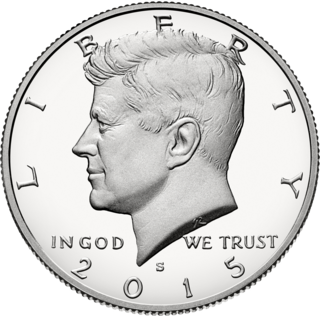
The Kennedy half dollar, first minted in 1964, is a fifty-cent coin currently issued by the United States Mint. Intended as a memorial to the assassinated 35th president of the United States John F. Kennedy, it was authorized by Congress just over a month after his death. Use of existing works by Mint sculptors Gilroy Roberts and Frank Gasparro allowed dies to be prepared quickly, and striking of the new coins began in January 1964.

The West Point Mint is a U.S. Mint production and depository facility erected in 1937 near the U.S. Military Academy in West Point, New York, United States. As of 2019 the mint holds 22% of the United States' gold reserves, or approximately 54 million ounces. The mint at West Point is second only to the gold reserves held in secure storage at Fort Knox. Originally, the West Point Mint was called the West Point Bullion Depository. At one point it had the highest concentration of silver of any U.S. mint facility, and for 12 years produced circulating Lincoln cents. It has since minted mostly commemorative coins and stored gold.

The Washington quarter is the present quarter dollar or 25-cent piece issued by the United States Mint. The coin was first struck in 1932; the original version was designed by sculptor John Flanagan.
The America the Beautiful quarters were a series of 56 25-cent pieces (quarters) issued by the United States Mint, which began in 2010 and lasted until 2021. The obverse (front) of all the coins depicts George Washington in a modified version of the portrait used for the original 1932 Washington quarter. There were five new reverse (back) designs each year, each commemorating a national natural or historic site such as national parks, national historic site, or national forests – one from each state, the federal district, and each territory. The program was authorized by the America's Beautiful National Parks Quarter Dollar Coin Act of 2008 (Pub.L. 110–456 .
Below are the mintage figures for the Washington quarter.

The Kennedy half dollar is a United States coin that has been minted since 1964. In the first year of production the coins were minted in 90% silver and 10% copper. From 1965 through 1970, the coins were minted in a clad composition of mostly silver outer layers and a mostly copper inner layer. After 1970, the coins are minted in a copper–nickel clad composition. From 1992 to 2018, 90% silver coins were made for inclusion in special "Limited Edition" silver proof sets. Beginning 2019 coins in the special silver proof sets are produced from pure (.9999) silver.
The United States Mint has released annual collections of coins most years since 1936.
American Innovation dollars are dollar coins of a series minted by the United States Mint beginning in 2018 and scheduled to run through 2032. It is planned for each member of the series to showcase an innovation, innovator or group of innovators from a particular state or territory.
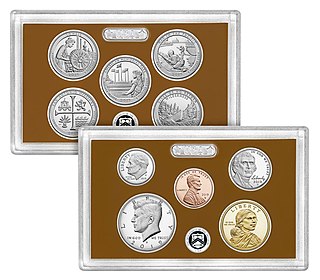
The United States Mint Proof Set, commonly known as the Proof Set in the United States, is a set of proof coins sold by the United States Mint. The proof set is popular with coin collectors as it is an affordable way to collect examples of United States coinage in proof condition.